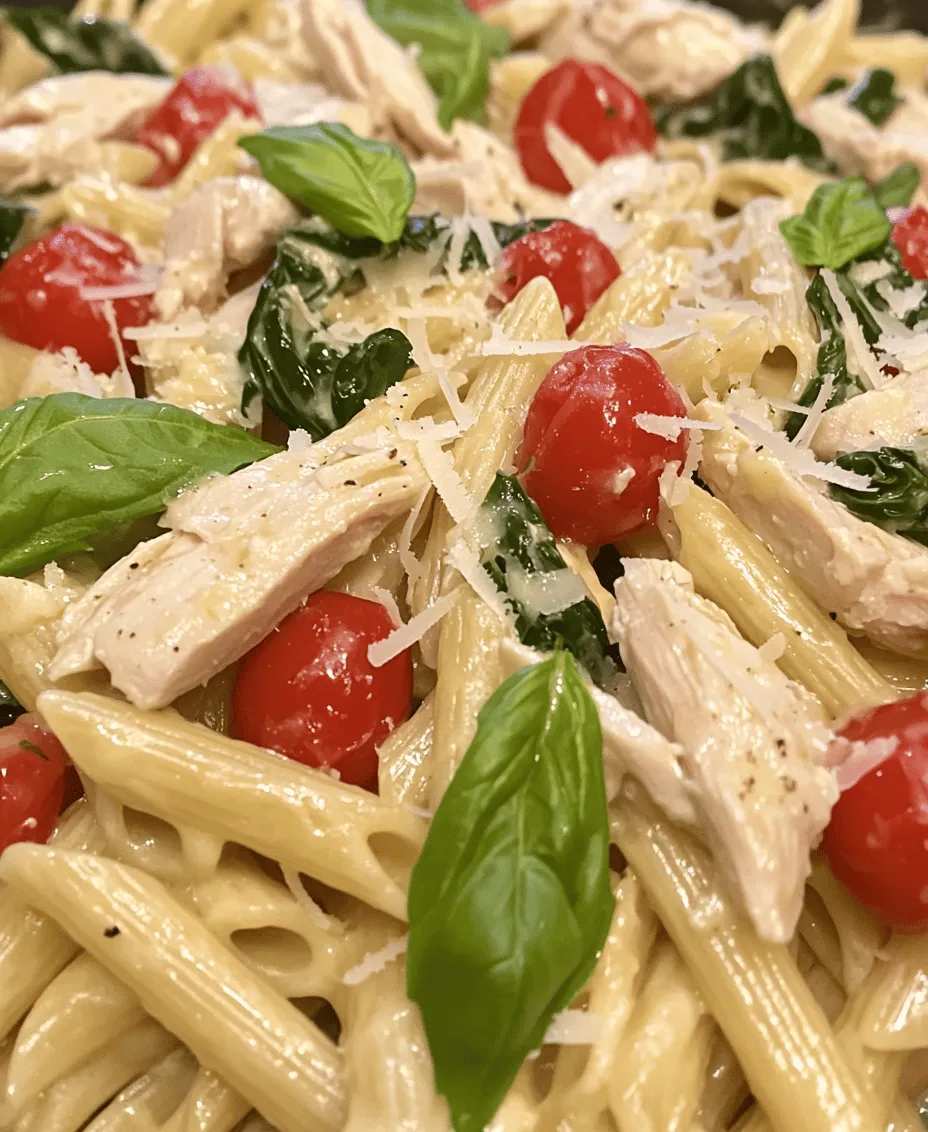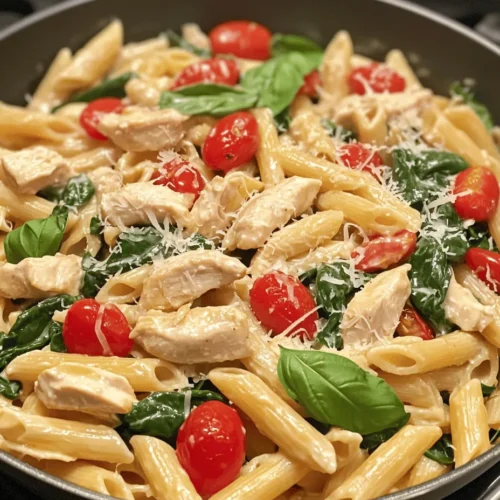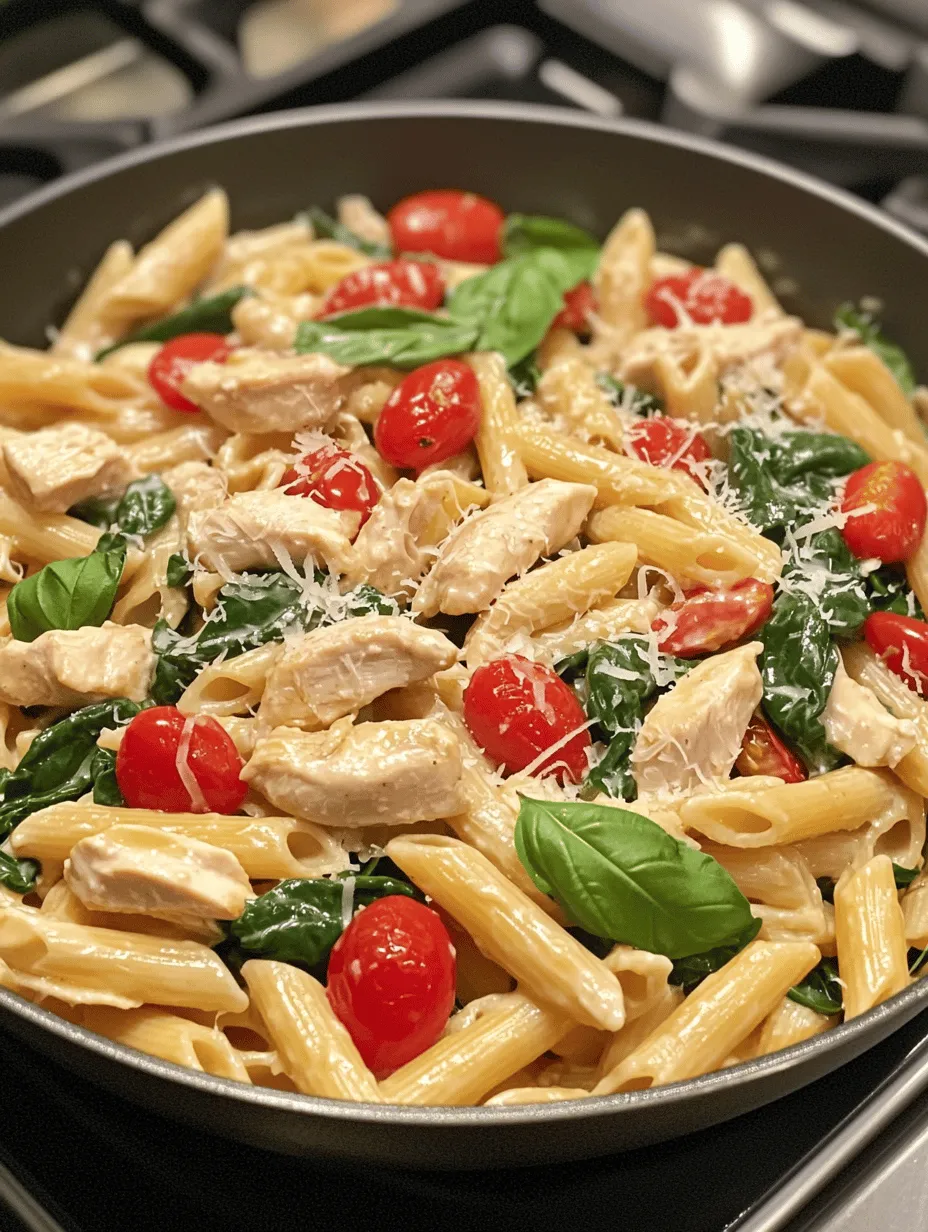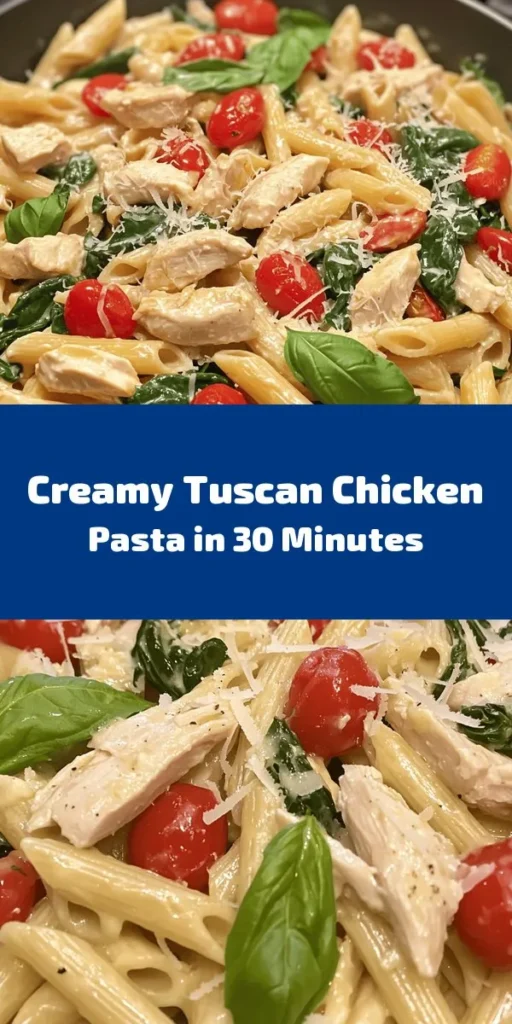In the realm of weeknight dinners, few dishes strike the perfect balance between simplicity and flavor quite like Easy Tuscan Chicken Pasta. This creamy, comforting dish is the epitome of Italian home cooking, bringing together tender chicken, vibrant vegetables, and pasta in a rich and savory sauce. Not only is it quick to prepare, but it’s also packed with fresh ingredients that evoke the rustic charm of the Italian countryside. Whether you’re looking to impress guests or simply enjoy a delightful meal with your family, this recipe is a go-to option that can be whipped up in under an hour.
In this blog post, we will dive into the ingredients, preparation steps, and some fascinating insights about Tuscan cuisine, ensuring you have a well-rounded understanding of this delicious dish.
Understanding Tuscan Cuisine
Exploring the Roots of Tuscan Cooking
Tuscan cuisine is steeped in history and tradition, reflecting the region’s agricultural roots and its emphasis on fresh, high-quality ingredients. Known for its simplicity, Tuscan cooking often highlights the natural flavors of its components rather than overwhelming them with complex techniques or excessive spices. The essence of Tuscan dishes can be traced back to the Mediterranean diet, which is renowned for its health benefits and focus on wholesome foods.
In Tuscan cuisine, staples such as olive oil, tomatoes, beans, and various herbs play crucial roles. These ingredients not only enhance the flavor of dishes but also contribute to the overall nutritional profile. The use of seasonal produce is integral to Tuscan cooking, allowing dishes to evolve throughout the year based on what is available.
The Importance of Fresh Ingredients
One of the hallmarks of Tuscan cooking is the emphasis on fresh ingredients. Using fresh produce not only elevates the taste of a dish but also ensures that it is brimming with nutrients. For instance, in Easy Tuscan Chicken Pasta, fresh garlic and tomatoes are essential for creating a robust sauce that complements the chicken and pasta.
Herbs and spices also play a significant role in Tuscan cuisine. Basil, rosemary, and oregano are commonly used to infuse dishes with aromatic flavors. They are often added towards the end of cooking to maintain their freshness and potency. When selecting ingredients for your Tuscan chicken pasta, opting for quality meats, fresh vegetables, and aromatic herbs will significantly enhance the dish’s overall appeal.
Additionally, using high-quality olive oil instead of less flavorful cooking oils is a vital aspect of Tuscan cooking. Extra virgin olive oil not only boosts the flavor profile but also offers numerous health benefits, including heart-healthy fats and antioxidants.
Ingredients Breakdown for Easy Tuscan Chicken Pasta
Essential Ingredients for a Flavorful Dish
To create a delicious Easy Tuscan Chicken Pasta, you will need a few key ingredients. Here are the main components that form the backbone of this recipe:
– Penne Pasta: This tubular pasta shape is ideal for holding onto the creamy sauce, ensuring each bite is flavorful.
– Chicken Breast: Lean and protein-rich, chicken breast serves as the primary source of protein in this dish. It cooks quickly and absorbs the flavors of the sauce beautifully.
– Spinach: Fresh spinach adds a pop of color and a wealth of nutrients, including vitamins A and K, while also contributing to the dish’s overall flavor.
– Cherry Tomatoes: These sweet and juicy tomatoes bring a burst of freshness and acidity, balancing the creamy elements of the dish.
– Heavy Cream: Vital for creating a luscious, creamy sauce that ties all the ingredients together.
– Parmesan Cheese: Grated Parmesan adds depth and a nutty flavor to the sauce, making it irresistibly rich.
– Garlic and Onion: Aromatics like garlic and onion are crucial for building flavor at the base of your sauce.
– Olive Oil: Used for sautéing the chicken and vegetables, high-quality olive oil enhances the overall taste and texture of the dish.
Each of these ingredients plays a vital role in achieving the creamy, savory flavor profile that Easy Tuscan Chicken Pasta is known for.
Nutritional Benefits of Key Ingredients
Understanding the nutritional benefits of the key ingredients in Easy Tuscan Chicken Pasta can help you appreciate the dish even more. Here’s a closer look:
– Chicken: As a lean protein source, chicken breast is low in fat and high in essential amino acids, making it an excellent choice for maintaining muscle mass and overall health.
– Spinach: This leafy green is packed with vitamins, minerals, and antioxidants. It is particularly high in iron, which is important for energy levels, and vitamin K, vital for bone health.
– Olive Oil: Rich in monounsaturated fats, olive oil supports heart health and can help reduce inflammation. It also contains antioxidants that can protect against chronic diseases.
By incorporating these wholesome ingredients, you not only create a delicious dish but also one that is nourishing and satisfying.
Step-by-Step Instructions to Create the Dish
Cooking the Perfect Pasta
The first step in making Easy Tuscan Chicken Pasta is cooking the penne pasta to perfection. Start by bringing a large pot of salted water to a boil. Salting the water is crucial because it adds flavor to the pasta as it cooks. A general rule of thumb is to use about 1 tablespoon of salt for every 4-6 quarts of water.
Once the water is boiling, add the penne pasta and cook according to the package instructions until it reaches al dente texture. Al dente means the pasta is firm to the bite, which is ideal for this dish as it will continue to cook slightly when mixed with the sauce. Avoid overcooking the pasta, as it can become mushy and lose its appealing texture.
Once the pasta is cooked, reserve about a cup of the pasta cooking water and then drain the rest. Set the cooked pasta aside while you prepare the chicken and sauce.
Sautéing Chicken to Perfection
While the pasta is cooking, it’s time to prepare the chicken. Start by cutting the chicken breast into bite-sized pieces. This not only helps the chicken cook faster but also allows it to absorb the flavors of the sauce more effectively.
Season the chicken pieces with salt and pepper, ensuring they are evenly coated. In a large skillet, heat a couple of tablespoons of olive oil over medium-high heat. Once the oil is shimmering, add the seasoned chicken pieces in a single layer.
Allow the chicken to sear without moving it around for about 3-4 minutes until it develops a golden-brown crust. This browning process adds depth to the flavor and enhances the overall taste of the dish. After the first side has browned, stir the chicken to cook the other side for an additional 3-4 minutes, until it is cooked through and no longer pink in the center.
Once the chicken is fully cooked, remove it from the skillet and set it aside. This step is crucial to ensure that the chicken remains juicy and tender, as overcooking can lead to dryness.
With this foundational understanding of Easy Tuscan Chicken Pasta, you will be well-equipped to continue with the preparation of the creamy sauce and the assembly of the dish. This recipe not only promises a delightful culinary experience but also allows you to explore the vibrant flavors of Tuscan cuisine right from your kitchen.
Stay tuned for the next steps where we will delve into creating the rich sauce and bringing all the elements together for a truly satisfying meal.

Recognizing the Signs of Properly Cooked Chicken
When preparing your Easy Tuscan Chicken Pasta, it is essential to ensure that your chicken is cooked perfectly. Properly cooked chicken is juicy and tender, with no pinkness remaining at the center. The USDA recommends an internal temperature of 165°F (75°C) for poultry. A meat thermometer is an invaluable tool for this task, providing an accurate reading. Additionally, look for clear juices running from the chicken; if they are pink or cloudy, it may need more cooking time.
Another visual cue is the color of the chicken. Cooked chicken should have a golden-brown exterior and should no longer appear translucent. If you cut into a piece of chicken and see any pink, return it to the heat and continue cooking until fully done. Remember, overcooked chicken can become dry, so aim for that perfect balance.
Incorporating Vegetables for Flavor and Nutrition
To elevate your Easy Tuscan Chicken Pasta, consider adding vegetables that contribute both flavor and nutrition.
Timing for Adding Garlic and Tomatoes
Garlic and tomatoes are integral to Tuscan cuisine, providing depth and richness to your dish. When cooking, add minced garlic to the skillet just before the chicken is fully cooked. This timing allows the garlic to infuse its aromatic flavor without burning. Be cautious, as burnt garlic can impart a bitter taste. Sauté for about 30 seconds until fragrant, then stir in the diced tomatoes. The acidity and sweetness of the tomatoes will complement the creaminess of the sauce beautifully.
Techniques for Wilting Spinach Without Losing Nutrients
Spinach is a fantastic addition to your pasta, adding both color and nutrition. To wilt spinach effectively without losing its essential nutrients, add it to the skillet just before combining with the cream sauce. Toss the fresh spinach into the pan with the garlic and tomatoes, allowing it to cook down for just a couple of minutes. The residual heat will wilt the spinach while preserving its vibrant green color and nutritional benefits.
Creating the Creamy Sauce
Once your chicken and vegetables are prepared, it’s time to create the creamy sauce that will tie the dish together.
Steps to Achieve the Right Consistency with Heavy Cream
To make a rich and creamy sauce, pour in the heavy cream gradually, stirring continuously. Start with about one cup of heavy cream, allowing it to simmer gently. This step is crucial; if you add the cream too quickly, it may not emulsify properly with the other ingredients. Allow the cream to heat through and thicken for about 5-7 minutes, stirring frequently to prevent it from sticking to the bottom of the pan. You’ll know it’s ready when it coats the back of a spoon.
Tips for Balancing Flavors with Salt, Pepper, and Italian Seasoning
Seasoning is vital to achieving a well-rounded flavor profile. Start with a pinch of salt and freshly cracked black pepper, tasting as you go. Italian seasoning, which typically includes basil, oregano, thyme, and rosemary, adds a bouquet of herbal notes that complement the dish beautifully. Add about a teaspoon of Italian seasoning; adjust to your preference, keeping in mind that you can always add more, but you can’t take away.
Combining Pasta and Sauce for a Delicious Finish
Now that your sauce is complete, it’s time to bring everything together.
Techniques for Ensuring Even Coating of Pasta and Sauce
To ensure that your pasta is evenly coated with the creamy sauce, first, reserve about a cup of pasta cooking water before draining the pasta. This starchy water can help loosen the sauce if it becomes too thick. After draining, add the pasta directly into the skillet with the sauce, tossing gently to combine. If the sauce seems too thick, add a splash of the reserved pasta water, stirring until the pasta is perfectly coated and every strand is enveloped in the creamy goodness.
The Importance of Adding Cheese at the Right Time
Cheese is a quintessential element in Tuscan cooking, and it’s no different for our Easy Tuscan Chicken Pasta. Grated Parmesan or Pecorino Romano adds a nutty flavor and enhances the creaminess of the sauce. To achieve the best results, add the cheese after combining the pasta with the sauce, stirring gently until it melts and integrates into the dish. This step ensures a smooth and creamy texture without clumping.
Serving Suggestions and Presentation Tips
Plating Your Easy Tuscan Chicken Pasta
Presenting your Easy Tuscan Chicken Pasta beautifully can elevate the dining experience. Use wide, shallow bowls for an elegant look. Begin by twirling the pasta in the center of the bowl, then arrange the chicken pieces artfully on top. This approach creates an appealing centerpiece for your dish.
Ideas for Garnishing with Fresh Basil
Garnishing with fresh basil not only adds a pop of color but also a burst of flavor. Tear the basil leaves gently and scatter them over the top just before serving. This fresh touch beautifully complements the creaminess of the sauce and enhances the overall presentation.
Suggested Serving Dishes for an Elegant Presentation
Consider using rustic-style ceramic dishes or clean white plates to highlight the vibrant colors of the pasta and sauce. Pair your pasta with a simple side salad dressed with a light vinaigrette to balance the richness of the dish. Crusty bread is also a perfect accompaniment to soak up any leftover sauce.
Pairing Wine with Tuscan Chicken Pasta
Recommended Wine Choices for a Complete Dining Experience
Wine pairing can elevate your meal, enhancing the flavors of your Easy Tuscan Chicken Pasta. A crisp Pinot Grigio or a medium-bodied Chianti pairs exceptionally well with the creamy sauce and chicken. The acidity of these wines cuts through the richness, creating a harmonious balance of flavors.
Tips for Selecting the Right Wine Based on Flavor Profiles
When selecting wine, consider the dominant flavors in your dish. For a cream-based sauce, look for wines with good acidity to balance the richness. Avoid overly heavy or sweet wines, which can overwhelm the dish. If you prefer white wine, choose one with citrus or herbal notes, and for red, opt for something light and fruity.
Variations and Modifications for Easy Tuscan Chicken Pasta
Exploring Alternative Ingredients
If you have dietary restrictions or preferences, there are numerous substitutions you can make without sacrificing flavor.
Substitutions for Dietary Restrictions: For gluten-free options, substitute traditional pasta with gluten-free pasta, such as brown rice or chickpea pasta. For those who are lactose intolerant or prefer a dairy-free option, consider using coconut cream or cashew cream as a substitute for heavy cream. Both options offer creamy textures while providing a unique flavor twist.
Incorporating Seasonal Vegetables for Added Flavor: Feel free to use seasonal vegetables in your Tuscan Chicken Pasta. Zucchini, bell peppers, or asparagus can be sautéed along with the chicken for added nutrition and flavor.
Creating a Vegetarian Version
For those looking to enjoy a vegetarian version of this dish, it is easy to adapt the recipe.
How to Adapt the Recipe Without Chicken: Replace the chicken with a hearty plant-based protein such as chickpeas or sautéed mushrooms. These alternatives provide texture and flavor, making the dish satisfying.
Suggestions for Protein-Rich Alternatives: Consider adding beans or lentils for an extra protein boost. Tofu can also be a delicious substitute; marinate it before sautéing to infuse additional flavor.
Conclusion: Enjoying Your Culinary Creation
In conclusion, Easy Tuscan Chicken Pasta is more than just a meal; it’s a celebration of flavors, textures, and the joy of cooking. With its rich, creamy sauce and vibrant ingredients, this dish embodies the heart of Tuscan cuisine while remaining accessible for any home cook. By following the steps outlined in this guide, you can create a satisfying dish that brings warmth and comfort to your table.
Embrace the simplicity and deliciousness of this recipe, and allow it to inspire your future culinary adventures. Whether you’re preparing it for a special occasion or a casual weeknight dinner, your Easy Tuscan Chicken Pasta will surely impress. Enjoy the process, savor each bite, and share the joy of this delightful dish with family and friends.



